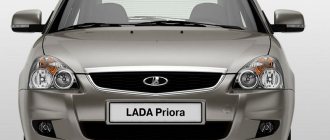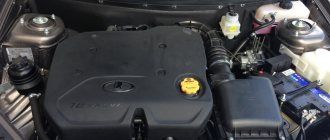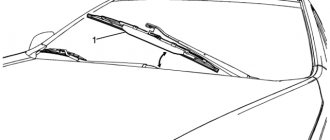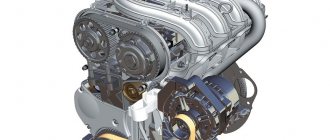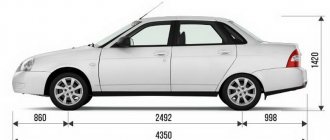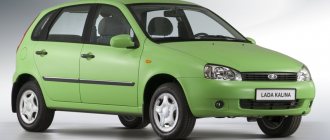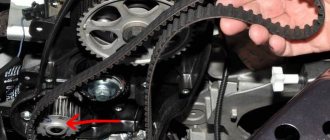I measured the trunk with a small margin
maybe it will be useful for someone to install a subwoofer)) Google says that the trunk volume is 430 l, I think I’ll believe it)
Before purchasing any car, the future owner carefully studies the main characteristics. The selection of a vehicle is primarily based on its power, efficiency, and safety.
Data on new modifications of familiar models is very important. For example, for a Lada Priora hatchback, the technical characteristics will indicate the updates received, modifications to the car and advantages over analogues in a different body.
Overall dimensions of Lada Priora Hatchback
The Priora hatchback has the smallest dimensions in length compared to all other body styles. Its length is 4240 mm in a 5-door body, and 4210 mm in a 3-door coupe body. The height is an intermediate position between a low sedan and a high station wagon, and is equal to 1435 mm. The width of the hatchback is no different from the same indicators of other bodies, and is 1680 mm. Ground clearance is 165 mm, although it is in the Priora Sport configuration slightly reduced, but in this version this car has already been discontinued. The dimensions of the car are something that needs to be taken into account when purchasing, since the dimensions of parking spaces, garages, turns or entrance arches are not always universal. The height is measured from the extreme point of the front to the extreme point of the rear bumper. The width is measured at the widest point, and the height is measured from the surface of the ground to the highest point of the roof. Roof rails and racks do not fit into the height of the body. Taking this into account, the dimensions of the Priora are as follows:
- The longest body of cars in this family is the sedan. It measures 4350 mm in length. But at the same time it is the lowest - 1420 mm. in height.
- The next longest is the station wagon, with its 4340 mm length. It is the highest in height – 1508 mm.
- The five-door hatchback and three-door coupe are the shortest - 4210 mm. at 1435 mm. in height.
In all four cases, the width of the Priora is the same - 1680 mm
Technical modification data
The modification is a good budget car. It belongs to class B and has a high degree of environmental friendliness - Euro4.
How much does a Hatchback body weigh? In factory configuration, without load, its weight is only 1088 kilograms.
Compared to other versions of the Priora, the suspension was not strengthened here. The front spring remained independent, and the rear was partially independent. The front brake is ventilated and has a disc locking type, the rear brakes are drum brakes. The use of a robotic automatic transmission in the modification made the car “friendlier” and easier to drive, even for inexperienced drivers.
The headlight glass has been changed in many ways to better distribute light. The body, interior, steering wheel and multimedia devices were also slightly changed.
What is good about the Lada Priora hatchback?
The answer to this question lies in the plane of what advantages such a body variation has in general. Firstly, it is a sportier and more dynamic look, which is preferred by young buyers, even taking into account the fact that the sedan looks more solid. Secondly, its compact size and the shortest wheelbase make it easier to maneuver and park in urban environments. Above we have already described the dimensions of the hatchback. Thirdly, the absence of a protruding stern, which creates difficulties when parking and reversing. Fourthly, a wide luggage opening (despite the fact that the Priora sedan has a larger trunk in volume), allowing for the stowage of large cargo.
Thus, the Priora hatchback is an excellent choice for those who do not burden themselves too much with pressing problems, preferring to devote time to the simple joys of life. This is a car for driving, not for transportation, which will be appreciated by young car enthusiasts, athletes, and those who do not intend to grow old.
Characteristics (performance characteristics): gearboxes priors
Priora is equipped with two gearboxes:
- mechanical;
- robotic.
The five-speed manual transmission is always stable. The owner’s task is to monitor it and give it proper care, without relying on the car to “fix itself.” The gear ratios are such that they make the car with six-valve engines reach “hundreds” in just 11 seconds.
The robotic automatic transmission also comes with five speeds. It is a slight modification of the old reliable Japanese Jatco box. According to AvtoVAZ, it is not inferior in acceleration to cars with manual transmission. Errors such as kicks during overclocking may occur. They can be removed by reprogramming the ECU. The clutch is a dry single-plate clutch with a diaphragm pressure spring inside. The clutch release drive is cable with automatic adjustment.
Pros and cons of a white car
Trunk volume of Priora hatchback. Lada Priora hatchback: technical characteristics and features of the model Advantages of painting a Priora white hatchback car:
• Of course, a chic appearance! White color can visually increase volume. Therefore, clean and sparkling in the sun, as if from a picture, the white Priora hatchback always has an impressive and at the same time elegant appearance.
• In dry weather, dust and dirt are much less visible on it than on cars with a dark color. Pollution becomes noticeable only from a close distance, but from a distance the car appears clean. Accordingly, cleaning costs are reduced.
• White color tends to reflect sunlight. This is especially felt in the summer heat. The white Priora hatchback (photo below) heats up much less.
• It is clearly visible on the road, including at night. This most likely determines the statistics of accidents - white cars get into them much less often.
• The purer the white color of your Lada, the less susceptible it will be to fading. In case of repairs and the need for touch-up, it will be much easier to choose a shade that best matches the original one.
• Small scratches and chips are much less noticeable. This is because paint primer is usually white. Therefore, if the scratch is shallow, then it is not visible.
• White Priora hatchback lends itself very well to modernization. Tuning (pictured), which will make your car original, can be done with your own hands.
Features of the modification
The Lada Priora sedan has two brothers - “Premier” and “Sport”. Premier is a version of Priora with a wheelbase extended by 175 mm. The “tradition” of making an extended version of the production model came from the VAZ-2110 - this version was also called “Premier”. The extended Priora began production in 2007. Its basic equipment contains much of what is found only in the luxury version of the VAZ-2170, and the center console, dashboard and door panels are complemented with wooden inserts that add style to this car.
All 175 mm “went” to the passengers on the rear sofa - it became much more spacious. However, they did not enlarge the glass - they simply installed another section, separating it from the main glass with a black plastic stand. The car's engine was revved up a bit - the Premier accelerates to 195 km/h, despite the fact that the car weighs 100 kg more than a regular Priora. This model was preferred by AvtoVAZ managers as a company car.
“Premier” and “Sport” cars were produced to order by Super-Avto CJSC from spare parts supplied by AvtoVAZ. The first copy of the Lada Priora Sport coupe was sold in 2010 - a year after the redesigned Priora participated in the WTCC races. In the sports version, they made minor modifications to the engine, but put more effort into the design - sports upholstery and “factory” tuning.
LADA Priora is one of the most expensive and at the same time best-selling domestic cars. Local car enthusiasts prefer the Priora because it is considered a car that has stood the test of time. But deciding on a car brand is only half the battle. It is clear that we are taking Priora. But here an “internal” dilemma arises: which Prior should we take? And if your wallet will quickly help you decide on the configuration, then choosing the body type is not so simple. Priora sedan or hatchback - which car is worthy of being in your garage?
Lada Priora is a time-tested car
Station wagons LADA Kalina, Priora
It is better for tall “high-altitude climbers” to bend down - here the door hangs a little closer to the head. But it is much more important that it is easier to lift the boxes: the loading height is less, and the side is half as low as in Kalina. Are you packed? Why did one of the boxes seem to have fallen through somewhere? It turns out that the side elements of the raised floor hang over the niches in the wings without any support. This means that a heavy load should be placed only in the middle of the floor, above the spare wheel. And so they did. And we realized: there is more free space here. True, the ill-fated generator with a ladder was left behind. Let’s resort to transforming the salon “furniture” again.
Sedan, sir
Priora sedan or hatchback is a tricky choice. And in order to do it correctly, “for yourself,” you need to know all the ins and outs.
Interestingly, the Priora sedan is the first model of this line. It is in this configuration that the Priora most closely resembles the ancestor of the “ten”, but the modernized interior, new engine and all sorts of modern “electric gadgets” indicate that the model has gone an order of magnitude higher. The sedan also has a softer suspension.
It turns out that the sedan has such a classic design. Of all the Priors, this car probably really looks more solid.
Review of the Lada Priora sedan:
Engine
Dimensions of the trunk of the VAZ-2112 in centimeters
The car is equipped with a gasoline engine with a displacement of 1.4 or 1.6 liters. The octane number of gasoline is 95.
The pre-styling Priora was always equipped with the following engines:
- 1.6 liters with a power of 98 hp. Consumption in the city is 9.8 liters per 100 km. Acceleration time to 100 is 11.5 seconds. Maximum speed – 183 km/h. This “baby” produced 98 hp. at 5600 rpm;
- 1.6 liters with 81 hp Consumption in the city is 9.8 liters per 100 km. Acceleration time to 100 is 13.5 seconds. Maximum speed – 172 km/h. This “baby” produced 81 hp. at 5200 rpm;
- 1.6 liters with 87 hp Consumption in the city is 9.8 liters per 100 km. Acceleration time to 100 is 12.5 seconds. Maximum speed – 176 km/h. This “baby” produced 87 hp. at 5100 rpm.
Engine after restyling
Coming off the assembly line in 2007, the car was equipped with 1 of 3 engines that were released gradually. Technical characteristics of LADA Priora 2010 look like this:
- Engine with 8 valves and 81 hp. At peak it produces 171 kilometers per hour, which was not bad at the time of release. Many drivers complained about inefficient fuel consumption: 7.5/100. Versions with this engine cost less than others, but they also ate much more gasoline.
- The 16-valve engine had 89 horsepower and could reach up to 176 kilometers. Fuel consumption is lower - 7.2 liters. In general, this medium engine was installed on the Optima version.
- The most “Top” version was equipped with an engine with 16 valves and 98 horsepower. It could accelerate 183 kilometers and consumed 7.4 liters.
Please note that now it makes no sense to buy cars produced before restyling. Buying spare parts can cost a pretty penny.
Lada Priora: choosing between body types
LADA Priora is one of the most expensive and at the same time best-selling domestic cars. Local car enthusiasts prefer the Priora because it is considered a car that has stood the test of time. But deciding on a car brand is only half the battle.
It is clear that we are taking Priora. But here an “internal” dilemma arises: which Prior should we take? And if your wallet will quickly help you decide on the configuration, then choosing the body type is not so simple.
Priora sedan or hatchback - which car is worthy of being in your garage?
Lada Priora is a time-tested car
Let's get to know each other better
VAZ has been producing Priora since 2007. It was created on the platform of the notorious “ten” and inherited a lot from it. Priora is called a car for young people. She is praised for her good speed and ability to stay on the road well. There are complaints about the build quality and the low cross-country ability is not suitable for everyone. Nevertheless, the car is extremely popular.
External upgrade
In 2013, VAZ presented an updated version of the Lada Priora. It was equipped with a number of new options, improving its technical capabilities. The car has also changed in appearance. The new Priora has modern daytime optics that turn on automatically. The bumper was slightly modified, and the grille on the radiator was made in the form of a mesh. LEDs are installed in the rear lights and fogs.
This is what a Lada Priora sedan looks like
Soft-look salon
What has changed in the salon? There's a lot to be said here. The designers used finishing materials atypical for VAZ, including soft-look - a new type of plastic that looks like expensive leather and at the same time withstands external influences well.
When finishing the interior of the Lada Priora car, a new type of soft-look plastic was used
A three-spoke steering wheel, a touch screen, more comfortable and higher seats with armrests - all this is the new Priora.
Motor data
The range of engines for this car has also been expanded. The coolest of them is designed for 1.6 liters. Its power is 106 “horses,” which is achieved thanks to an updated fuel injection system. With such an engine, the car accelerates to 100 km/h in 11 seconds and is ready to “give jazz” at speeds of 185 km/h and above. Gasoline consumption is 6.9 liters in mixed mode, and on the highway - 5 liters.
The car is front-wheel drive with 5 manual transmission.
Manufacturers paid special attention to safety issues, however, if the driver's airbag is included in the basic kit, then you will have to pay extra for the passenger airbag.
This is what a Lada Priora hatchback looks like
Tell me what body is yours...
The car is available in four body styles, but the most popular versions are the sedan and hatchback. There are also station wagons and coupes, which are not as popular.
Let us remember that a sedan is a body with a luggage compartment, which is linearly separated from the passenger compartment. This is the most common body type among passenger cars. But the hatchback has a smaller trunk and a shortened rear overhang.
The trunk of the Lada Priora sedan holds 430 liters of cargo
Millimeter difference
Which is better - Lada Priora sedan or hatchback? Let's compare the dimensions. The Priora sedan is slightly longer than its competitor: 4350 mm versus 4210 for the hatchback.
These models also differ in height: the hatchback has “grown” to 1435 mm, being 15 mm ahead of the sedan. But the width of the cars is equal, it is 1680 mm.
Both cars also have the same ground clearance (165 mm) and track width of the front and rear wheels (1410 mm and 1380 mm, respectively).
An interesting point: the cars are almost identical in fuel consumption.
Your luggage
As we have already said, the sedan and hatchback differ in trunk capacity. In the case of the Priora, it looks like this... If the sedan takes 430 liters of cargo “on board”, then the hatchback in its original position is ready to take only 360 liters. At the same time, however, in the hatchback it is possible to fold the rear sofa and thereby increase the capacity of the luggage compartment to 705 liters.
If you fold the rear sofa of the Lada Priora hatchback, you get a cargo volume of 705 liters
Sedan, sir
Priora sedan or hatchback is a tricky choice. And in order to do it correctly, “for yourself,” you need to know all the ins and outs.
Interestingly, the Priora sedan is the first model of this line. It is in this configuration that the Priora most closely resembles the ancestor of the “ten”, but the modernized interior, new engine and all sorts of modern “electric gadgets” indicate that the model has gone an order of magnitude higher. The sedan also has a softer suspension.
It turns out that the sedan has such a classic design. Of all the Priors, this car probably really looks more solid.
Review of the Lada Priora sedan:
Adrenaline hatchback
The Priora in the hatchback body began to be produced a year later than the sedan - in 2008. Compared to the sedan, as car enthusiasts say, the rear lights, rear wheel arch, and body sides look better in the hatchback.
In general, the “shortened” Priora is more generous with interesting maneuvers and boasts the ability to increase the luggage compartment.
They say that the Priora hatchback has a certain sporty character and is therefore in demand among adrenaline junkies.
Review of the Lada Priora hatchback:
Add a comment Cancel reply
You must be logged in to post a comment.
Among domestic car enthusiasts you can often meet gardeners, summer residents, fishermen, tourists, builders, installers and other lovers of large trunks in cars. It’s not for nothing that the well-known “four” held a high rating among VAZ cars for so long - low cost and excellent capabilities for transporting various cargoes. And if you want to choose a car for yourself that will give you the opportunity to transport various weights, then you will have to try hard, because the volume of the trunk is far from the most important thing. It is equally important to take into account a number of other points:
- width, length and height
- dimension of the opening for loading with the trunk lid open
- ability to fold rear passenger seats
- luggage compartment bottom edge height
- trunk lining material
In this article we will take a closer look at the capabilities of the Lada Vesta: trunk volume and other loading characteristics.
Summary data for Lada Priora (before restyling 2022)
Recommended tire and wheel sizes for Lada Kalina 2 (hatchback and station wagon)
The VAZ 2170 (this is exactly the indexing that Priora received) has an improved interior compared to the “ten”, a 16-valve engine with a volume of 1596 cc. see, and a 5-speed manual transmission in all trim levels (in the first trim levels of the sedan and hatchback with an 80 hp engine, an 8-valve engine was installed).
In mixed driving mode, the Priora has 100 km. it takes from 6.6 to 7.6 liters. fuel outside the city (depending on the configuration), and in the city – 9.8 liters. The new engine allows you to accelerate to 180 km/h, and to “hundreds” in 12 seconds
This property attracts the attention of fans of high-speed racing, because by working on the engine and tuning the car, you can achieve good sports performance
Performance characteristics of the Priora car engine: 126 and 127, how many horsepower and torque
The technical characteristics of the Priora car engine show 98 and 106 horsepower on board. This applies to engines with a displacement of 1.6 liters.
- Motor - 98 horsepower received number 21126. Maximum torque - 4000 rpm at 145 Nm.
- Motor - 106 horsepower is listed under number 21127, torque - 4,200 rpm at 148 km.
Motor 21127 is a modified version of the 126 model, but both of them are available with sixteen valves. In addition, the Priora has two eight-valve engines with a displacement of 1.6 liters, which produce 81 and 87 hp, but they are not as common as newer versions. Interestingly, there are engines with a volume of 1.8 liters.
- The first 1.8 liter engine produces 98 hp. (21127 also works), but the torque is 3000 rpm at 160 Nm.
- The 123 hp engine, which was installed on sports versions, produces 4000 rpm at 165 Nm.
Compared to the weight of the car, sixteen-valve engines are sufficient for free movement.
As for the technical condition, the VAZ-21126 and subsequent models are superior to eight-valve versions of engines, which is why car owners choose them more often. The most common “layout” is the Priora sedan with a 21126 engine and a manual transmission.
Drawing conclusions
For the money, the Priora is a great car. Both in the city and on the dirt road he behaves purposefully. The body type has practically no effect on its “filling”. That is, the presence of air conditioning or electric power steering does not depend at all on whether you are driving a sedan or a hatchback.
The technical differences between the sedan and the hatchback are not that fundamental. This means that when choosing a Lada Priora sedan or hatchback, focus more on appearance. What do you like? A roomy classic car or a sports car with fancy taillights?
Also keep in mind that for a sedan you will pay a minimum of 345 thousand rubles, and for a hatchback they ask for a minimum of 354 thousand rubles. The cost of luxury versions starts from 442 thousand rubles for a sedan and from 446 thousand rubles for a hatchback.
Dimensions
The Lada Priora with a hatchback body has the most “modest” dimensions in its series. The length of the five-door version is only 4.24 meters, the three-door version is slightly shorter - 4.21. The height parameters are average, in comparison with the low-set sedan and the high “station wagon” - 1.43 meters.
The width is the same as other body types - 1.68 meters. Almost all versions have a clearance height of 16.8 centimeters, with the exception of the “Sport” line, where it is slightly lower.
Technical characteristics of the VAZ-2170
VAZ-2170 (LADA PRIORA) sedan
| 1.6 l. 8th grade (Euro-3) | 1.6 l. 16 classes (Euro-3) | |
| Length, mm | 4350 | 4350 |
| Height, mm | 1420 | 1420 |
| Base, mm | 2492 | 2492 |
| Front wheel track, mm | 1410 | 1410 |
| Rear wheel track, mm | 1380 | 1380 |
| Luggage compartment volume, cubic meters dm. | 430 | 430 |
| Weight in running order, kg | 1088 | 1088 |
| Gross vehicle weight, kg | 1578 | 1578 |
| Permissible total weight of a towed trailer with brakes, kg | 800 | 800 |
| Permissible total weight of a towed trailer without brakes, kg | 500 | 500 |
| Wheel formula / drive wheels | 4 x 2 / front | 4 x 2 / front |
| Car layout diagram | front-wheel drive | front-wheel drive |
| Body type / number of doors | sedan / 4 | sedan / 4 |
| engine's type | gasoline, four-stroke | gasoline, four-stroke |
| Supply system | distributed injection with electronic control | distributed injection with electronic control |
| Number and arrangement of cylinders | 4, in-line | 4, in-line |
| Engine displacement, cubic meters cm | 1596 | 1596 |
| Maximum power, kW/rpm. | 59,5/5200 | 72/5600 |
| Maximum torque, Nm at rpm | 120/2700 | 145/4000 |
| Fuel | unleaded gasoline AI-95 (min) | unleaded gasoline AI-95 (min) |
| Fuel consumption by driving cycle, l/100 km | 7,6 | 7.2 |
| Maximum speed, km/h | 172 | 183 |
| Transmission | with manual control | with manual control |
| Number of gears | 5 forward, 1 reverse | 5 forward, 1 reverse |
| Main gear ratio | 3,7 | 3,7 |
| Steering | rack and pinion type | rack and pinion type, electric power steering |
| Transfer case | ||
| Number of RK transmissions | ||
| Tires | 185/65 R14 (86, H); 175/65 R14 (82, H); 185/60 R14 (82, H) | 185/65 R14 (86, H); 175/65 R14 (82, H); 185/60 R14 (82, H) |
| Fuel tank capacity, l | 43 | 43 |
VAZ-2172 (LADA PRIORA) hatchback
| 1.6 l. 16 classes (Euro-3) | |
| Length, mm | 4210 |
| Width, mm | 1680 |
| Height, mm | 1420 |
| Base, mm | 2492 |
| Front wheel track, mm | 1410 |
| Rear wheel track, mm | 1380 |
| Luggage compartment volume, cubic meters dm. | 400 |
| Weight in running order, kg | 1088 |
| Gross vehicle weight, kg | 1578 |
| Permissible total weight of a towed trailer with brakes, kg | 800 |
| Permissible total weight of a towed trailer without brakes, kg | 500 |
| Wheel formula / drive wheels | 4 x 2 / front |
| Car layout diagram | front-wheel drive, front engine, transverse |
| Body type / number of doors | hatchback / 5 |
| engine's type | gasoline, four-stroke |
| Supply system | distributed injection with electronic control |
| Number and arrangement of cylinders | 4, in-line |
| Engine displacement, cubic meters cm | 1596 |
| Maximum power, kW/rpm. | 72/5600 |
| Maximum torque, Nm at rpm | 145/4000 |
| Fuel | unleaded gasoline AI-95 (min) |
| Fuel consumption by driving cycle, l/100 km | 7,2 |
| Maximum speed, km/h | 183 |
| Transmission | with manual control |
| Number of gears | 5 forward, 1 reverse |
| Main gear ratio | 3,7 |
| Steering | rack and pinion type, electric power steering |
| Transfer case | |
| Number of RK transmissions | |
| Tires | 185/65 R14 (86, H); 175/65 R14 (82, H); 185/60 R14 (82, H) |
| Fuel tank capacity, l | 43 |
Suspension characteristics
The Priora's chassis was designed for smooth driving over bumps and obstacles, as well as driving along a country road. Of course, the VAZ-2170 is not an SUV, but it can easily go through many places. The front part of the suspension is independent, and the rear part is semi-independent, which makes the car softer.
Many owners almost immediately replace the anti-roll bar arms along with the struts with a sports kit - so that the car does not wobble when making a sharp turn. Telescopic shock absorbers consistently dampen vibrations when driving over obstacles, so there will be no problems with it. The VAZ-2170 is a front-wheel drive car.
- Front suspension is MacPherson type with longitudinal braces.
- The rear suspension is also with trailing arms. It has a U-shaped transverse beam, to which a torsion-type anti-roll bar is attached.
As for the ground clearance, for the pre-restyling version it was 165 mm, and for the restyled version it was 170 mm. The wheelbase is 249.2 cm, the front track width is 141 cm, the rear track is 138 cm. The suspension can be lowered or raised if desired - ready-made kits for modernization are available for open sale.
Technical characteristics of Lada Priora hatchback
As for the dimensions, the hatchback is 140 mm shorter than the sedan and 1.5 centimeters higher. The width and wheelbase of the cars are the same. As for wheel sizes, 14-inch wheels are standard on all Priors. The clearance of the Lada Priora hatchback is 165 mm. It is worth noting that the luggage compartment of the hatch is smaller than that of the sedan, however, with the rear seats folded down, the loading space almost doubles. Below are detailed dimensions and dimensions of the machine.
Dimensions, trunk, dimensions of Lada Priora hatchback
- Length - 4210 mm
- Width - 1680 mm
- Height - 1435 mm
- Curb weight / gross weight - 1185 / 1578 kg
- Front/rear wheel track - 1410 / 1380 mm
- Base, distance between front and rear axle - 2492 mm
- Trunk volume - 360 liters
- Trunk volume with seats folded - 705 liters
- Fuel tank volume - 43 liters
- Tire size - 175/65 R14 or 185/60 R14 or 185/65 R14
- Ground clearance of the Lada Priora hatchback is 165 mm
As for power units and transmissions. The Lada Priora is still a front-wheel drive car with a 5-speed manual transmission. An automatic transmission will definitely appear; the manufacturer promises to release a Priora with automatic transmission closer to the fall of 2014.
Interestingly, after restyling, the Lada Priora hatchback lost its 1.6-liter 8-valve power unit. Today the well-known 16-valve engine with a power of 98 hp is offered, plus its more advanced version with a complex exhaust system and passive supercharging, which already produces 106 hp. The gas distribution mechanism still functions thanks to the tension belt and idler roller. Avtovaz claims that the belt has a fairly long service life. However, it is advisable to change the belt regularly. Below are the parameters of the Priora hatchback engines.
Characteristics of the VAZ-21126 engine (98 hp)
- Working volume - 1596 cm3
- Number of cylinders/valves - 4/16
- Power hp/kW - 98/72 at 5600 rpm
- Torque - 145 Nm at 4000 rpm
- Maximum speed - 183 kilometers per hour
- Acceleration to the first hundred - 11.5 (manual transmission 5) seconds
- Fuel consumption in the combined cycle - 6.9 (manual transmission 5) liters
Characteristics of the VAZ-21127 engine (106 hp)
- Working volume - 1596 cm3
- Number of cylinders/valves - 4/16
- Power hp/kW - 106/78 at 5800 rpm
- Torque - 148 Nm at 4200 rpm
- Maximum speed - 183 kilometers per hour
- Acceleration to the first hundred - 11.5 (manual transmission 5) seconds
- Fuel consumption in the combined cycle - 6.8 (manual transmission 5) liters
Dimensions and dynamic data of Priora hatchback
The solid hatchback has small but sufficient dimensions: length - 4.21 m, width - 1.68 m, height - 1.43 m. The internal space was reduced due to the small external dimensions, but had minimal impact on the comfort of travel for second-row passengers.
The technical characteristics of the Priora hatchback also had a slight impact on the trunk volume. In the sedan, the luggage compartment volume is 430 liters, and in the hatchback it is 360 liters.
The model is equipped with 1.6 liter petrol engines. The power plant is combined with manual or 5-speed automatic transmissions. Engine power is 87, 98 and 106 hp, the maximum possible speed is 176 (183) km/h. The technical characteristics of the hatchback indicated for the Lada Priora lead to the following fuel consumption in mixed mode: from 6.6 to 7.3 liters. The maximum figure applies to a model with an automatic transmission.
Trunk volume of Lada Priora hatchback: size and characteristics
Among all the Priors, the hatchback has the smallest trunk volume - 360 liters versus 430 for the sedan and 444 in the universal body. Of course, the trunk of any hatchback is always smaller than that of the same sedan car. However, is 360 liters a lot or a little? This number is not extremely small or extremely large for hatchbacks, so you will have to compare it with similar characteristics of other cars. For example, the trunk of the Priora hatchback is only 10 liters less than that of the Hyundai Solaris and 29 liters less than the KIA Rio, but has much more volume than the trunks of the Renault Sandero and Ford Fiesta. In this regard, the 360-liter trunk is considered spacious, and already on this basis the economic qualities of the car can be considered good.
In general, modern passenger cars are equipped with trunks with a volume of 300 to 500 liters, if you do not take into account purely sports cars or semi-trucks with a station wagon body, which enjoy little consumer interest. Therefore, the trunk of the Priora hatchback can be considered average in capacity. And if the developers initially set themselves the task of creating a hatchback with a more spacious trunk, then they would have to increase the dimensions of the car, going beyond the given class, price segment, or remove the rear sofa. If 360 liters is not enough for someone, then the Priora’s capacity can be increased by folding the rear seat backs or removing it completely.
Body dimensions and weight of the Lada Priora car - hatchback, station wagon, sedan, coupe, long
The ideal car is different for everyone - it all depends on why they are buying it. Priora is perfect for both the younger generation and the older. The weight that it can lift varies - for example, the station wagon received a voluminous trunk that can accommodate more things. The width of the Priora remains unchanged - exactly 164 cm. The weight of the car ranges from 1578 to 1598 kg.
Hatchback
When it comes to overall dimensions, the Lada Priora cannot but rejoice - you can drive with it even in the narrowest yard. The curb weight of the hatchback is 1163 kg, the maximum permissible is 1578 kg. The trunk volume is 360 liters, and with the seats folded down – 705 liters. Height is 143.5 cm, length – 421 cm.
Sedan
The dimensions of the sedan are slightly different, but the weight of the car remains the same. The trunk volume is 430 liters. The sedan body dimensions are 142 cm in height, length is 435 cm.
Station wagon
The improved technical characteristics of the Lada Priora station wagon allow you to seriously load the trunk - they took care of the reinforced suspension in advance. Unlike the hatchback, the station wagon has a length of 13 cm longer - 434 cm. The height is 150.8 cm. The trunk volume is 444 liters and 777 liters with the seats folded down. The total weight can be equal to 1598 kg.
Coupe
The three-door hatchback Lada Priora was produced in a sports version and featured improved characteristics - after restyling, there were 123 horses under its hood. The body elements had to be redone, which did not affect the dimensions so much. Length is 424.3 cm, height 143.5 cm.
Long body
The extended Priora is the Premier version, premium. Its base was lengthened by 17.5 cm, the rear door was made larger, and an additional section was added to the glass. Under the hood there is a noticeable advantage - more “horses” are needed to pull a heavier car. The salon is decorated elegantly and stylishly. The width remains the same - 168 cm, the length is 452.5 cm, and the height is 142 cm. The curb weight is 1100 kg, and the trunk volume remains the same - 430 liters.
Sport car
Very often, cars of the VAZ family are chosen as racing cars, especially for amateur competitions. One of the most suitable for these purposes is the white Priora hatchback. Pictures of sponsors advertising, riders' names and serial numbers are visible from afar on a white background.
Even the basic version of the car, the white Priora hatchback, features a sporty look. Tuning (photo below) will give it an aggressive and brutal look. Of course, a lot of work is required to upgrade the standard equipment to the racing version. But, as shown in the photo, the white Priora hatchback allows you to do it even in a garage, especially since there are no problems with purchasing components and spare parts for the Lada.
Such wide possibilities make the Priora white hatchback one of the most versatile. It is purchased by both young people - as a sports or city car, and adult family citizens - as a reliable means of transportation around the city and to the garden. Both men and women look natural behind the wheel of such a car. And car buying companies, for example, https://kupilauto.ru, are happy to purchase these cars.
Modifications of Lada Priora 2172
The pre-restyling model in the hatchback body was sold on our market from 2008 to 2013.
There was no need to choose a box before restyling, but there were several units at once:
| 1.6 l 21114 80 hp 120 Nm and 5-speed manual transmission VAZ 2170 |
| 1.6 l 21116 87 hp 140 Nm and 5-speed manual transmission VAZ 2170 |
| 1.6 l 21126 98 hp 145 Nm and 5-speed manual transmission VAZ 2170 |
The updated hatchback model was offered on our market only from 2013 to 2015.
After modernization, a new manual transmission, a robot and a more powerful 16-valve engine appeared:
| 1.6 l 21116 87 hp 140 Nm and 5-speed manual transmission VAZ 2181 |
| 1.6 l 21126 98 hp 145 Nm and 5-speed manual transmission VAZ 2170 |
| 1.6 l 21127 106 hp 148 Nm and 5-speed manual transmission VAZ 21806 |
| 1.6 l 21127 106 hp 148 Nm and 5-speed gearbox AMT 2182 |
Modifications
- VAZ-2170 - Sedan, mass production since March 2007.
- VAZ-2172 - Hatchback, serial production since February 2008.
VAZ-2171 - Station wagon, serial production is planned for the end of 2008.
- VAZ-21708 Priora Premier - Its body is 175 mm longer than the standard Priora in the rear door opening, which should provide greater comfort for rear passengers and a more comfortable fit. Small-scale production is carried out by AvtoVAZ's partner - the Togliatti company Super-Auto. Equipped with a 1.8 liter VAZ-21128 engine with a power of 100 hp. In 2008, 15 cars were assembled, in 2009 it is planned to assemble 200 “premiers”.
- Coupe - plans to organize small-scale production of a three-door model based on a hatchback.
Weight of LADA Priora
The carrying capacity of the VAZ Priora I 1.8 MT sedan is 490 (kg).
Weight of popular modifications:
Curb weight of LADA Priora modifications of different generations:
- VAZ Priora I 1.6 MT sedan (2007 - 2013): 1088 (kg) 1578 (kg).
- VAZ Priora I 1.6 MT hatchback (2008 - 2013): 1088 (kg) 1578 (kg).
- VAZ Priora I 1.6 MT station wagon (2013 - present): 1185 (kg) 1593 (kg).
- VAZ Priora I 1.8 MT sedan (2014 - present): 1088 (kg) 1578 (kg).
The value of the permissible gross vehicle weight is indicated in parentheses.
Car load capacity:
The arithmetic difference between a vehicle's gross vehicle weight and its curb weight is the vehicle's payload capacity. For example, for the VAZ Priora I 1.8 MT sedan, the load capacity is determined as follows:
Important: the VAZ Priora I 1.6 MT station wagon is one of the heaviest cars in the model range, its curb weight is 1185 (kg), and the total permissible weight is 1593 (kg).
The head car of the family of Russian cars of the III group of small class LADA Priora is the VAZ-2170.
Priora sedan
Priora sedan began production in 2007 and at the same time became the first model in its line, a kind of high-quality addition to the higher-level VAZ 2110.
There is an improved interior, modern electrical equipment, and a powerful engine. At the same time, the car has a representative classic appearance. It is created by a solid body, a separate trunk and a softer suspension.
The disadvantages of the Priora sedan are:
- protruding parts of the car, giving it poor handling;
- the smallest trunk compared to other representatives of the selected line.
If the capacity of the car you choose is not important to you, you can safely choose this model.
Checkpoints:
The dimensions of the trunks are taken using control points, which have an individual location for various modifications of the car; in most cases, their location on the drawings is as follows:
- A: top left corner;
- B: top right corner;
- E: inseam to the far left (bottom corner);
- D: Inseam to the far right (bottom corner).
Important: if, due to the structural features of the car body, the trunk does not have standard control points, then the data is provided in the length/width/height format.
Tuning
Like all VAZ models, the LADA Priora Universal (VAZ 2171) can be easily tuned, with the help of which it can be transformed into a completely different car, unlike the production one. In this case, changes can be made to almost all nodes.
The easiest way to implement changes is in the station wagon's interior. It is enough to change the original upholstery material to a more textured and brighter color, and also decorate the dashboard and door panels with original metal or wooden (imitation of precious wood) inserts. The Priora will also be given more solidity by replacing the standard front seats with Recaro seats. The salon will immediately acquire individuality.
Station wagon styling
You can completely change the exterior of the VAZ 2171 Priora station wagon by:
- glass tinting;
- installation of new thresholds and aerodynamic body kits;
- use of forged wheels and low-profile tires;
- tuning of front optics and radiator grille.
Additionally, you can decorate the body with vinyl film and install a decorative trim on the heater air intake. All this will allow you to change the usual image of a station wagon beyond recognition.
Technical tuning
If necessary, you can improve the technical characteristics of the VAZ 2171 station wagon by subjecting it to technical tuning.
The main procedure that needs to be carried out is to increase the cylinder capacity of the station wagon engine to 1.8 liters. Besides:
- carry out modifications to the cylinder block;
- install lightweight flywheels and gas distribution valves;
- change the throttle valve and other parts.
Attention! Having increased the power, it is necessary to bring the controllability and stability of the VAZ 2171 Priora station wagon in accordance with it. We offer a review of the most practical car from the entire Lada Priora family
appeared on sale back in 2009, two years after the start of sales of sedans. Lada Priora station wagon is the most spacious and roomy car of the entire Priora family. However, the length of the station wagon is 1 centimeter shorter than the sedan, but longer than the hatchback. At the same time, the wheelbase of all three body options is the same.
The luggage compartment volume of the Priora station wagon is 444 liters
, however, if you fold the rear seats, the volume of loading space increases to 777 liters. The most interesting thing is that the seats still do not fold into a perfectly flat floor.
As for the latest restyling, which took place in 2013, the car has remained virtually unchanged in appearance. Apart from the new radiator grille, bumpers, turn signals built into the exterior mirrors and optics with daytime running lights, by the way, the rear lights now have LEDs.
However, the technical part and interior have undergone more serious changes. Thus, a more powerful power unit of 106 hp appeared on the new generation Lada Priora station wagon. This engine is not a new development, but a modernized 98 hp engine. As for the transmission of the front-wheel drive station wagon, Avtovaz designers modified the manual gearbox, and a new cable clutch appeared. There is no automatic transmission option yet, but as the manufacturer promises, Lada Priora with automatic transmission will hit the production line at the end of summer 2014
. In addition, the sound insulation of the Lada Priora station wagon has been slightly improved.
But the first thing that clearly catches your eye on the new Priora is the interior. There are new seats with a fabric that is more practical and pleasant to the touch. By the way, in rich trim levels, the front seats have built-in side airbags and heating with three power levels. The steering wheel is now three-spoke. The center console has a color monitor, which is not only an element of the stereo system, but can also act as a navigator screen.
And of course, pay attention to the updated center console and dashboard. There are also photos of the trunk of the Lada Priora station wagon
Brake system
The front and rear brakes are different. There are ventilated disc brakes with a single-piston floating caliper and automatic adjustment of the gap between the pads and the disc at the front, and drum brakes at the rear. The brake system is diagonal, dual-circuit, hydraulic. Equipped with a vacuum booster.
It is possible to work with the traction control system. You can also install disc brakes at the rear instead of standard drum brakes. The new braking system will also support ABS. The parking brake is manual, on a cable with drive of the rear wheels.
Operational deficiencies
Like most domestic cars, Priora has a rather weak paint coating, as a result of which the body of used cars is covered with chips and scratches. However, the problem with the low quality of metal and the level of anti-corrosion treatment is much more acute. As a result, the car quickly begins to become covered with rust, showing hot spots in various places. The most susceptible to corrosion are wheel arches, doors, sills and hood.
Engine
Both gasoline engines have proven themselves well during operation and are unpretentious in maintenance. The biggest problems are caused by electronic sensors, which cannot serve as a standard for durability. Quite often the throttle valve and the gasket between the head and the cylinder block fail due to the low quality of gasoline. When it gets dirty, the car stalls and loses traction. During operation of the machine, it is necessary to pay sufficient attention to the operation of the cooling system. Quite quickly, especially in the summer, the thermostat can fail, which can lead to overheating of the engine with all the ensuing consequences. Car enthusiasts will not be pleased with the long service life of the ignition coil and fuel pump. The car has a timing belt drive and, according to the manufacturer, its service life is 200 thousand kilometers. However, do not forget that as a result of a broken belt, the valve bends and you have to do a major overhaul of the engine. Therefore, owners of LADA Priora 2008 recommend changing it along with the rollers and pump at least every 100 thousand km.
Transmission
Despite the fact that the car is equipped with no alternative to a manual transmission, this gearbox cannot serve as a standard of reliability. The main disadvantage is weak synchronizers, which, however, is typical for manual transmissions installed on all AvtoVAZ models. The main sign of their failure is a characteristic crunch, which is clearly audible when changing gears. Priora received enhanced clutch from, but the problem of the limited service life of the release bearing was never solved. The service life of the transmission can be extended by using high-quality oil and regularly changing the fluid in the box, which must be done at least once every 75 thousand kilometers.
Chassis and steering
Surely many car enthusiasts are familiar with the problems of domestic cars associated with the short service life of the suspension. However, LADA Priora in this component can compete on equal terms with most budget foreign cars presented on the secondary market. Stabilizer bushings fail most quickly. As a rule, this happens already at 10–20 thousand km. mileage Following them, the stabilizer struts will have to be changed. Steering tips and wheel bearings will last about 40 - 50 thousand km. Replacement of ball joints and support bearings will be required after a mileage of 60 - 70 thousand km. Shock absorbers, CV joints and silent blocks of front levers can last 100 - 120 thousand kilometers. The original brake pads may not survive the first 10 thousand km, so the driver will have to quickly replace them with better analogues.
Poor quality operation of the electric power steering can cause certain troubles. The main signals of such a malfunction are jerking and heaviness when turning the steering wheel. The problem can be resolved by cleaning the electrical wiring contacts of the unit.
Other faults
Both the quality of the materials used for interior decoration and the level of assembly itself deserve great criticism, as a result of which car enthusiasts will have to put up with numerous extraneous sounds throughout the entire period of operation. Moreover, every year there will be more and more of them. Additional installed sound insulation and pasting of elements with vibration-absorbing materials do not help get rid of them either. The driver will constantly have to deal with malfunctions of electrical equipment, which occur mainly due to oxidation of contacts.
Disadvantages, breakdowns and problems of Lada Priora 2172
Body
The body is highly susceptible to corrosion and rust may appear after the first winter. The paintwork is not the most durable; chips form quickly and immediately turn yellow.
Salon
The interior is very cramped, especially in the back, and there are a lot of ergonomic miscalculations. Noise insulation is weak, squeaks appear from the first km and only intensify with mileage.
But most of all the problems are caused by electrics; something constantly breaks down. This is some kind of endless process, you fix one thing and immediately something else breaks.
Engine
Four 1.6-liter engines have similar problems, let's list them in a single list:
- Sensors often fail, and in updated internal combustion engines there is an electronic throttle valve
- The thermostat may unexpectedly jam, which will lead to overheating and gasket breakdown
- Lubricant leaks regularly occur, as well as fogging of the crankcase ventilation breather
- The worst thing is a broken timing belt due to old age, jammed rollers or pump
Transmission
The main manual transmission of the VAZ 2170 is a reinforced version of the manual transmission from the Lada 110 and is known for weak synchronizers, release knocks and unclear shifting.
The new mechanics of the VAZ 2180 with a cable drive are much more pleasant to use. The VAZ 2182 robot received very mixed reviews, read a separate article about it.
Suspension
But there are much fewer questions regarding the chassis of the car. The suspension here is quite reliable; by 100,000 km, steering tips, wheel bearings, and ball joints are usually replaced.
The brakes are not bad if you buy normal pads instead of the stock ones as soon as possible. The first years of production there were failures with the electric power steering, but then everything got better.
Specifications
Below we will talk about each element of the Lada Priora separately, namely, we will consider separately the body, engine, trunk, etc.
Body
Priora was produced in several bodies. In 2007, only a sedan appeared; later, in 2008, the first hatchback and station wagon rolled off the assembly line.
Sedan 2170
This body turned out to be very nice and most popular among young people. Young people started buying Priora and subjecting it to various tunings. It became a kind of youth movement.
Station wagon 2171
This type of body is an excellent solution for family people. The station wagon is equipped with a huge trunk.
Hatchback 2172
The hatchback does not differ from the sedan in technical characteristics and the front part of the body, but is shorter by several centimeters, which is noticeable to the naked eye.
Engine
Several types of engines with different power and number of valves were installed on the Lada. The table below shows all installed engines and their characteristics.
| Model | 21126 | 21127 | 21116 |
| Number of valves | 16 | 16 | 8 |
| Power (hp) | 98 | 106 | 87 |
| Type | Petrol | Petrol | Petrol |
| Torque, |
145/4000 148/4200 140/3800 Number of cylinders 4 4 4
Cylinder arrangement In-line In-line In-line
Volume (cubic cm) 1596 1596 1596
Fuel Gasoline AI 95 Gasoline AI 95 Gasoline AI 95
Power type Electronic injection Electronic injection Electronic injection
Maximum speed, km/h 183 183 172
Acceleration time to 100 km/h 11.5 11.0 12.5
Average fuel consumption per 100 km 7.2 7.2 7.6
Gear box
Priora was equipped with several gearboxes depending on the configuration and year of manufacture of the car. All gearboxes are 5-speed
Gearbox with rocker
This gearbox was installed on cars from 2007 to 2013. It is a fairly reliable and unpretentious gearbox, its main “soreness” is the weak second gear, which begins to fly out over time.
Cable gearbox
Installed on cars since 2014. Received a large number of positive reviews, the position of the gears, namely the reverse gear, has changed. The vibrations transmitted to the cabin from the gearbox have been reduced.
Robotic gearbox
In 2014, luxury car models began to be equipped with a robotic gearbox. It is very reliable and unpretentious, but noticeably loses in dynamics compared to a manual transmission.
Lada modifications of the sedan of the Priora car are the pioneer of the brand, code 2170. Russian budget city car, produced by AvtoVAZ from 2007 to 2022. Over the years, the car has been mass-produced in four bodies: sedan, hatchback, station wagon and coupe. Each of these versions found its buyer among certain groups of car enthusiasts, and the Lada Priora sedan even in popular culture. Remember the song: Lada Sedan eggplant!
The car has a balanced weight of 1088 to 1185 kg and engine power, making it dynamic. At the same time, fuel consumption does not exceed 9-10 liters. Which is appropriate for the city! The price of the entire car also hit the bull's eye. Over time, people preferred to buy a new car instead of a foreign car that was 20 years old.
The Priora sedan became the first car option for young drivers. All impressions boil down to the fact that for its class the car is comfortable, ergonomic and, moreover, smoothly goes over bumps and is inexpensive for spare parts.
Technical modification data
The modification is a good budget car. It belongs to class B and has a high degree of environmental friendliness - Euro4.
How much does a Hatchback body weigh? In factory configuration, without load, its weight is only 1088 kilograms.
Compared to other versions of the Priora, the suspension was not strengthened here. The front spring remained independent, and the rear was partially independent. The front brake is ventilated and has a disc locking type, the rear brakes are drum brakes. The use of a robotic automatic transmission in the modification made the car “friendlier” and easier to drive, even for inexperienced drivers.
The headlight glass has been changed in many ways to better distribute light. The body, interior, steering wheel and multimedia devices were also slightly changed.
Let's sum it up
The Priora in the hatchback body can be tuned indefinitely. In fact, absolutely all elements of the vehicle can be upgraded. It all depends on the flight of your imagination and financial capabilities. Tuning is a painstaking work that requires responsibility, attentiveness and hard work from the performer.
As a result, a car tuned with your own hands will delight you with an excellent look and improved performance.
The first Lada Priora rolled off the assembly line in 2007. A couple of years later, this car became very popular among domestic car enthusiasts, mainly because of its affordable price. At the same time, many car owners strive to give their Priora individuality. Make it look more solid and more expensive. Tuning helps them with this. Let's figure out what this procedure is.
Sources
- https://lanister.ru/test-obzor/razmery-bagazhnika-priora-hetchbek.html
- https://granta-service.ru/prochee/obem-bagazhnika-lady-priora-hetchbek-razmer-i-harakteristiki.html
- https://ProAutoMarki.ru/priora-hetcbek/
[collapse]
Engine after restyling
Coming off the assembly line in 2007, the car was equipped with 1 of 3 engines that were released gradually. Technical characteristics of LADA Priora 2010 look like this:
- Engine with 8 valves and 81 hp. At peak it produces 171 kilometers per hour, which was not bad at the time of release. Many drivers complained about inefficient fuel consumption: 7.5/100. Versions with this engine cost less than others, but they also ate much more gasoline.
- The 16-valve engine had 89 horsepower and could reach up to 176 kilometers. Fuel consumption is lower - 7.2 liters. In general, this medium engine was installed on the Optima version.
- The most “Top” version was equipped with an engine with 16 valves and 98 horsepower. It could accelerate 183 kilometers and consumed 7.4 liters.
Please note that now it makes no sense to buy cars produced before restyling. Buying spare parts can cost a pretty penny.
Adrenaline hatchback
The Priora in the hatchback body began to be produced a year later than the sedan - in 2008. Compared to the sedan, as car enthusiasts say, the rear lights, rear wheel arch, and body sides look better in the hatchback. In general, the “shortened” Priora is more generous with interesting maneuvers and boasts the ability to increase the luggage compartment. They say that the Priora hatchback has a certain sporty character and is therefore in demand among adrenaline junkies.
Review of the Lada Priora hatchback:
